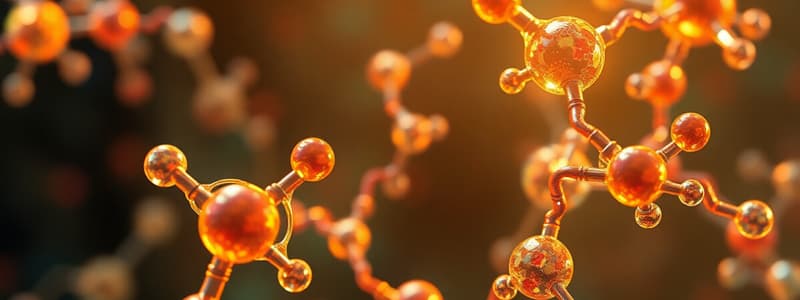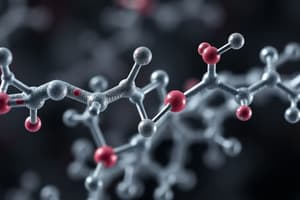Podcast
Questions and Answers
What is chitin primarily used for in medical applications?
What is chitin primarily used for in medical applications?
- To enhance tissue regeneration
- To bond synthetic materials together
- To produce a strong and flexible surgical thread (correct)
- To create a waterproof seal
Which of the following describes lipids?
Which of the following describes lipids?
- Lipids are comprised mostly of hydrocarbons and are hydrophobic (correct)
- Lipids have high affinity for water
- Lipids form polymers to create complex structures
- Lipids are soluble in water due to polar bonds
What two types of molecules are fats constructed from?
What two types of molecules are fats constructed from?
- Glycerol and cholesterol
- Glycerol and amino acids
- Glycerol and fatty acids (correct)
- Fatty acids and steroids
How do fats behave in the presence of water?
How do fats behave in the presence of water?
What are the characteristics of saturated fatty acids?
What are the characteristics of saturated fatty acids?
What structural feature leads to the bending of unsaturated fatty acids?
What structural feature leads to the bending of unsaturated fatty acids?
What type of linkage connects fatty acids to glycerol in fats?
What type of linkage connects fatty acids to glycerol in fats?
Which of the following statements is true regarding lipids?
Which of the following statements is true regarding lipids?
What are the four classes of large biological molecules that make up all living things?
What are the four classes of large biological molecules that make up all living things?
Which of the following statements accurately describes a polymer?
Which of the following statements accurately describes a polymer?
What occurs during a dehydration reaction?
What occurs during a dehydration reaction?
What is the reverse process of dehydration that disassembles polymers into monomers?
What is the reverse process of dehydration that disassembles polymers into monomers?
Which of the following statements is true regarding macromolecules?
Which of the following statements is true regarding macromolecules?
What type of fats are solid at room temperature?
What type of fats are solid at room temperature?
Which of the following is NOT a major function of fats?
Which of the following is NOT a major function of fats?
What is the primary characteristic of phospholipids?
What is the primary characteristic of phospholipids?
Which fatty acids must be supplied in the diet?
Which fatty acids must be supplied in the diet?
What is the basic structure of a steroid?
What is the basic structure of a steroid?
Where are phospholipids primarily found?
Where are phospholipids primarily found?
Which function is NOT attributed to proteins?
Which function is NOT attributed to proteins?
What is the primary role of omega-3 fatty acids in the diet?
What is the primary role of omega-3 fatty acids in the diet?
What is cholesterol's role within animal cells?
What is cholesterol's role within animal cells?
Which statement about unsaturated fats is true?
Which statement about unsaturated fats is true?
What is the primary function of storage proteins?
What is the primary function of storage proteins?
Which of the following is an example of a hormonal protein?
Which of the following is an example of a hormonal protein?
What function do receptor proteins perform?
What function do receptor proteins perform?
Which type of protein is primarily responsible for muscle contraction?
Which type of protein is primarily responsible for muscle contraction?
Which protein type provides structural support in animal connective tissues?
Which protein type provides structural support in animal connective tissues?
What is the role of transport proteins in the body?
What is the role of transport proteins in the body?
How do transport proteins contribute to blood function?
How do transport proteins contribute to blood function?
What is the primary function of contractile proteins?
What is the primary function of contractile proteins?
What is the simplest form of carbohydrates?
What is the simplest form of carbohydrates?
Which type of sugar is glucose classified as?
Which type of sugar is glucose classified as?
What type of reaction forms a disaccharide from two monosaccharides?
What type of reaction forms a disaccharide from two monosaccharides?
What is the main storage polysaccharide in plants?
What is the main storage polysaccharide in plants?
Glycogen is primarily stored in which types of cells in animals?
Glycogen is primarily stored in which types of cells in animals?
The structural polysaccharide cellulose differs from starch in which way?
The structural polysaccharide cellulose differs from starch in which way?
Which polysaccharide serves structural roles in fungi and the exoskeleton of arthropods?
Which polysaccharide serves structural roles in fungi and the exoskeleton of arthropods?
How are monosaccharides usually represented in terms of their molecular formula?
How are monosaccharides usually represented in terms of their molecular formula?
Which bond forms between two monosaccharides during a dehydration reaction?
Which bond forms between two monosaccharides during a dehydration reaction?
Which of the following statements is true about cellulose?
Which of the following statements is true about cellulose?
What characteristic distinguishes alpha glucose from beta glucose?
What characteristic distinguishes alpha glucose from beta glucose?
How do herbivores digest cellulose?
How do herbivores digest cellulose?
Which of the following carbohydrates is made solely from glucose monomers?
Which of the following carbohydrates is made solely from glucose monomers?
Which type of carbohydrate is a polymer composed of many sugar building blocks?
Which type of carbohydrate is a polymer composed of many sugar building blocks?
Flashcards are hidden until you start studying
Study Notes
The Molecules of Life
- All living organisms are composed of four main types of large biological molecules: carbohydrates, lipids, proteins, and nucleic acids.
- Macromolecules are large molecules constructed from thousands of covalently linked atoms.
- Molecular structure and function are interconnected.
Macromolecules are polymers, built from monomers
- Polymers are long molecules comprised of repeating smaller subunits called monomers.
- Carbohydrates, proteins, and nucleic acids are all polymers.
Synthesis and Breakdown of Polymers
- Dehydration reactions create bonds between monomers by removing a water molecule.
- Hydrolysis breaks down polymers by adding a water molecule, breaking the bonds.
Carbohydrates serve as fuel and building material
- Carbohydrates include sugars and polymers of sugars.
- Monosaccharides are simple sugars, while polysaccharides are polymers of many sugar units.
Sugars
- Monosaccharides have molecular formulas that are multiples of CH2O.
- The most common monosaccharide is glucose (C6H12O6).
- Monosaccharides are classified as either aldoses (containing an aldehyde group) or ketoses (containing a ketone group), and by the number of carbon atoms.
Polysaccharides
- Polysaccharides serve as storage or structural molecules.
- Their structure and function are determined by the arrangement of their sugar monomers and glycosidic linkages.
Storage Polysaccharides
- Starch is a storage polysaccharide in plants, composed of glucose monomers.
- Plants store starch as granules within chloroplasts and other plastids.
- Amylose is the simplest form of starch.
- Glycogen is a storage polysaccharide in animals, primarily stored in liver and muscle cells.
Structural Polysaccharides
- Cellulose is a major component of plant cell walls, also composed of glucose monomers.
- Cellulose and starch differ in the configuration of their glycosidic linkages, which affects their structure.
- Cellulose has a straight, fibrous structure due to its glucose monomers.
- These fibers create strong building materials for plants.
- Humans lack the enzymes to break down cellulose, which is why it’s considered dietary fiber.
- Chitin is a structural polysaccharide found in the exoskeletons of arthropods, and the cell walls of fungi.
Lipids are a diverse group of hydrophobic molecules
- Lipids are a class of non-polymer large biological molecules.
- They are hydrophobic because they consist mostly of hydrocarbons.
- The main types of lipids are fats, phospholipids, and steroids.
Fats
- Fats are constructed from glycerol and fatty acids.
- Glycerol is a three-carbon alcohol with a hydroxyl group on each carbon.
- Fatty acids have a carboxyl group attached to a long carbon chain.
- Three fatty acids join to glycerol via ester linkages to form a triacylglycerol, or triglyceride.
Fatty Acids
- Fatty acids vary in length and the number and position of their double bonds.
- Saturated fatty acids have no double bonds and are solid at room temperature.
- Unsaturated fatty acids contain one or more double bonds and are liquid at room temperature.
- Essential fatty acids, like omega-3 fatty acids, are not synthesized in the body and must be consumed.
Functions of Fats
- Fats serve primarily for energy storage.
- Mammals store fat in adipose cells, which also cushions vital organs and provides insulation.
Phospholipids
- Phospholipids contain two fatty acids and a phosphate group attached to glycerol.
- The fatty acid tails are hydrophobic, while the phosphate group and its attachments form a hydrophilic head.
- In water, phospholipids form a bilayer with hydrophobic tails facing inward and hydrophilic heads facing outward.
- They are the major component of all cell membranes.
Steroids
- Steroids have a distinct structure with four fused rings.
- Cholesterol is an important steroid found in animal cell membranes.
- High cholesterol levels in the blood can contribute to cardiovascular disease.
Proteins include a diversity of structures with a wide range of functions
- Proteins make up over 50% of the dry mass of most cells.
- They perform various functions including structural support, storage, transport, cellular communication, movement, and defense.
Protein Functions
- Enzymatic proteins catalyze chemical reactions.
- Defensive proteins protect against disease.
- Storage proteins store amino acids.
- Transport proteins transport substances.
- Hormonal proteins coordinate cellular activities.
- Receptor proteins bind to signaling molecules.
- Contractile and motor proteins facilitate movement
- Structural proteins provide support.
Studying That Suits You
Use AI to generate personalized quizzes and flashcards to suit your learning preferences.




